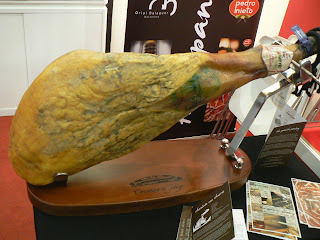 Poilane. See the heavy snow.
Poilane. See the heavy snow. Poilane cushions, not miche :=)
Poilane cushions, not miche :=) Poilane backroom with bread chandelier
Poilane backroom with bread chandelier Poilane slices with Proscuitto de Parma and Meslun assembled in hotel room
Poilane slices with Proscuitto de Parma and Meslun assembled in hotel room Gosselin
Gosselin Baguette Ancienne
Baguette Ancienne Breads at Borough market
Breads at Borough market Breads at Borough market
Breads at Borough marketVisit to Poilane and Gosselin in Paris
Ever since I started baking Artisanal bread, I have always wondered what the real stuff tastes like. Although I have had slices of Poilane which has been shipped here, the bread was already past its prime.
I finally got a chance to visit Poilane recently. Despite the heavy snow on that day, I managed to visit Gosselin also. Unfortunately there just wasn't enough time to visit Kayser , Boubsa and Ganachaud.
The people at Poilane were obliging in answering my questions. I requested for a visit to their wood fired oven in the basement but the lady said that they entertained visits only in the Summer.
Trudging in the heavy snow with slush all round with an armful of stuff was worse than an army route march. With one hand holding an umbrella, the other hand holding a map to navigate the streets of Paris and bags and bags of wife's shopping dangling from the arm, it was an ordeal that only a bread fanatic could endure. I had to call it quits after 2 bakeries as it was getting dark.
At Gosselin, I was surprised that the Baguette Ancienne cost less than local baguettes at 1.15 Euro. Baguette Ancienne, which Peter Reinhart described so much in his book selling for less than our local baguette in Paris??? and we are talking about the baguette which won the Parisian baguette of the year.
Over in the Borough Market in London, there were stalls selling the most beautiful breads and the only reason why we don't hear of such bakers is that they don't write books nor do they have on online presence.
It was certainly an eye opening experience and it made me realise that there are many superb bakers and bakeries out there other that those we know from the books. The bakeries in Switzerland were superb and the breads there were exceptionally good. The only regret I had was being unable to carry all those bread home.
















































